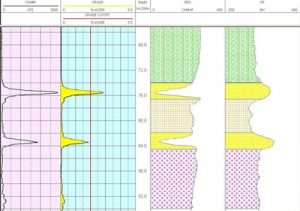Gamma Uranium Logging
Total Count Gamma Tool for Uranium Exploration
Down Under Surveys uses a Total Count Gamma tool to detect uranium mineralization in drill holes. In order to do this and provide accurate estimates of the grade of the uranium present; the tools have been calibrated against known grades.
 The calibration of our tools is carried out in Adelaide, at the Department of Water, Land and Biodiversity Conservation, where there are calibration pits that have been constructed, under the supervision of the CSIRO, to provide for the calibration of radiometric tools. DUS calibrates all tools used for Uranium regularly, or at least every 18 months, at this facility.
The calibration of our tools is carried out in Adelaide, at the Department of Water, Land and Biodiversity Conservation, where there are calibration pits that have been constructed, under the supervision of the CSIRO, to provide for the calibration of radiometric tools. DUS calibrates all tools used for Uranium regularly, or at least every 18 months, at this facility.
The basic theory behind obtaining a grade using a total count radiometric tool is as follows. Uranium decays naturally through a chain of radioactive daughter products to the finally inert Pb206. Uranium itself has a relatively low radioactivity. Most of the gamma rays measured using the total count system are therefore those of the daughter products.
About 98% of the gamma rays detected come from the radium group of isotopes (Ra226 through Pb206). Approximately 95% of these gamma rays come from the decay of just two isotopes - Bi214 and Pb214. By using these known ratios, and assuming the decay is in equilibrium, a straightforward calculation can be made to determine the actual amount of U308 is present.
As this decay series reaches equilibrium over many thousands of years some of the components of this chain may be preferentially removed or added. When this occurs, it creates disequilibrium in the decay series and no longer allows the measured quantity of gamma rays to give a true estimate of the U3O8 grade.
Disequilibrium can be determined by measuring the radiometric grade and the chemical assay grade for the same hole. The total count radiometric eU3O8 can then be corrected by multiplying by the disequilibrium ratio (the difference between the two measurements). This ratio if uniform can then be used for the correction of the other drill holes in that project area.


